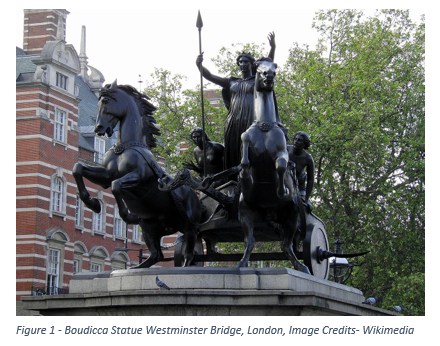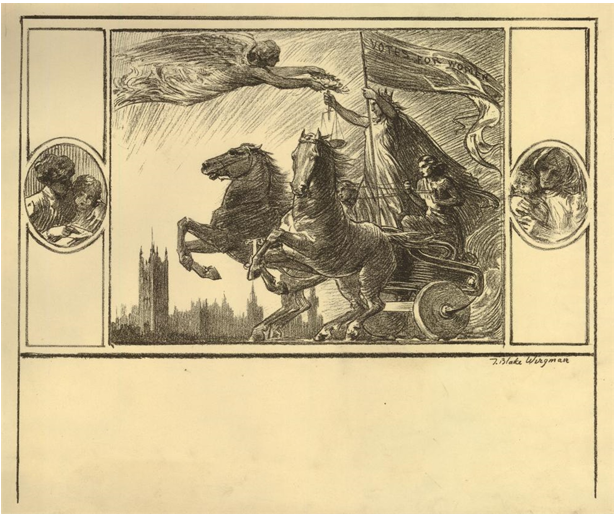Without One Brave Enough to Challenge Us We Will Never Change - Katie Tipple
As you walk over Westminster Bridge, down Parliament Square, the legacy of those who have shaped the world around us is clear to see. For me, I’ve found my attention is naturally drawn to the statue of Boudicca and her daughters. Despite living over 2000 years ago, I believe Boudicca’s story can teach us a lot about activism in the modern world.

Boudicca’s story is known to us primarily through the voices of the male literary elite based in the Roman Empire. She seems to have become the sole female leader of her tribe, the Iceni, with whom Rome came into conflict during their invasion of Britain in the first century AD. According to Tacitus (Annals 14.31), Boudicca and her daughters were violated and humiliated by Roman soldiers after the death of her husband, prompting her to ignite a rebellion against them. She united with other tribes across southern Britain, sacking Colchester, London, and St Albans, before meeting the Roman army in a battle at which she was seriously outnumbered (Annals 14.33). Despite being defeated that day, Tacitus claims Boudicca rallied her assembled forces by calling them to defend their liberty from the pollution of Roman greed (Annals 14.34-37).
Tacitus’ description of Boudicca’s actions is grounded in his own literary objectives as much as historical reality. Yet, over time, Boudicca has become an icon of feminist history and campaigning. As Marguerite Johnson notes, Boudicca “was a woman, mother and ruler, with her sex and maternity never impeding or negating her right to rule” (2014). During the women’s suffrage movement in Britain, the world paid particular attention to figures like Boudicca. She was included alongside other historical women in The Pageant of Great Women, a play produced by the Actresses’ Franchise League and held in November 1909 at the Scala Theatre in London (Johnson 2014). She also became a symbol in much of the protest media at the time, ranging from banners at rallies to cartoons. Modern history will be familiar with the phrase “Deeds not Words”, most commonly associated with the Women’s Social and Political Union when they went on hunger strike. Much like Boudicca in her rebellion, these women took extreme actions to achieve their desired aim: securing the vote for women. Numerous individuals stand out from the wider collective of women who campaigned for change. Perhaps the most famous is Emily Wilding Davison, who walked onto the track (and sadly to her death) at the 1913 Epsom Derby. But there are many more, such as the numerous women who defaced the 1911 census in protest.
Boudicca’s statue near Westminster Bridge became an embodiment of this message of defiance. Construction on the statue started in 1856, when the work was originally envisioned as an expression of British imperialism, but it was only later put on display in 1902. In doing so, the statue placed a powerful woman and her daughters outside the Houses of Parliament during a key point of the women’s suffrage movement. Unsurprisingly, the statue became an emblem in suffragette media, including a 1921 print by Theodore Blake Wirgman depicting Boudicca flying the Votes for Women flag herself:

Figure 2 - Print depicting Boudicca with the Votes for Women flag (Image credit: British Museum)
Looking back, it seems to me that these two things were likely linked, especially when reflecting on the power clearly shown on the statue and in the inscription below. The gold lettering stands out for the elegant detailing at the bottom of the bronze sculpture, informing passers-by about who Boudicca is and why she should be remembered: “Boudicca, Queen of the Iceni who died AD 61 after leading her people against the Roman invader” (War Memorials Register, Imperial War Museums). Walking under the statue, it’s clear that she was a powerful figure. Her crown, the height of the statue, and her open position, all combine to make an unforgettable image. The movement of the galloping horses, frozen in time I find makes me think of the battlefield she fought upon all those years ago. A true leader, standing up for what she believed in.
Boudicca’s message of defiance feels relevant now more than ever in the story of women’s freedom. As a young female student, I’m only too familiar with the many dangers I face in everyday life. High-profile crimes such as the rape and murder of Sarah Everard and the murder of Sabina Nessa in 2021 clearly demonstrate that sadly women’s safety is still a key issue. I look back to figures like Boudicca (and the suffragettes who celebrated her) for hope, to see the progress that has already been made. We are strong enough to work for change, to create a world where women can go out without fearing the worst.
In our modern world, it’s easy to feel powerless against our issues. But, as Eleanor Roosevelt famously said, “The choices we make are ultimately our responsibility.” We control our actions, it is up to us to be brave enough to work for what is right, to stand up and challenge what is wrong. For me, the legacies of those who came before remind me to be brave, to empower those around me. If it weren’t for those who came before us, we wouldn’t be able to celebrate the world we live in today. The easiest way for us to thank them is to continue their legacy of amazing work and fearless leadership. For me, my family taught me to follow my destiny, always remain true to myself, and go wherever the adventures of life take me.
After all, well-behaved women rarely make history.
Bibliography
Tacitus Annals. Translation by J. Jackson (1937) Loeb Classical Library, Harvard University Press. Available at: http://penelope.uchicago.edu/Thayer/E/Roman/Texts/Tacitus/Annals/14B*.html
‘Boudecia-Boudicca’ War Memorials Register, Imperial War Museums. Available at: https://www.iwm.org.uk/memorials/item/memorial/55473
Alsop, Ben (2018) ‘Suffrage objects in the British Museum’ British Museum Blog. Available at: https://blog.britishmuseum.org/suffrage-objects-in-the-british-museum/
Cox, Alex (2020) ‘5 defiant suffrage statements found in the 1911 census’ Find My Past Blog. Available at: https://www.findmypast.co.uk/blog/discoveries/suffragettes-in-the-1911-census
Johnson, Marguerite (2014) ‘Boadicea and British Suffrage Feminists’ Volume 31. Available at: https://www.outskirts.arts.uwa.edu.au/volumes/volume-31/marguerite-johnson
